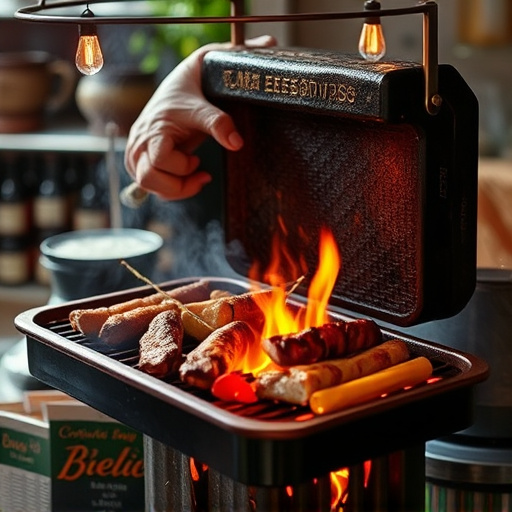Mastering the perfect BBQ beef ribs involves a blend of traditional techniques and quality ingredients. Start with high-quality ribs, marinate in brown sugar, paprika, garlic powder, salt, and pepper, then smoke at 225°F (107°C) for 3-8 hours. Brush on barbecue sauce and honey during the last hour for a delectable blend of smoky and sweet flavors that will delight your taste buds.
“Elevate your BBQ game with a recipe that promises smoky and sweet ribs every time. This comprehensive guide uncovers the secrets behind perfecting this classic dish. From choosing the ideal beef ribs to mastering dry rubs, smoking techniques, and glazing, we’ll walk you through each step. Learn how to balance flavors, achieve the perfect texture, and finish with an impressive glaze. With serving suggestions tailored for guests, impress and delight with your newfound BBQ beef ribs recipe expertise.”
- Unlocking the Secret to Smoky and Sweet Ribs
- The Art of BBQ: A Step-by-Step Guide
- Choosing the Right Beef Ribs for Your Dish
- Master the Dry Rub: Balancing Flavors
- Smoking Technique: Achieving Perfection
- Glazing for That Extra Layer of Deliciousness
- Cooking Time and Temperature Considerations
- Serving Suggestions to Impress Your Guests
Unlocking the Secret to Smoky and Sweet Ribs
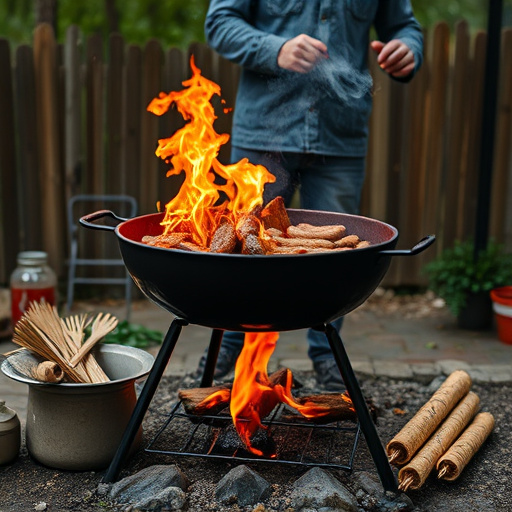
Unleashing the perfect balance of smoky and sweet flavors in every bite of BBQ beef ribs is an art that many culinary enthusiasts strive to master. The key lies in a meticulous combination of spices, slow cooking techniques, and a clever use of smoking. For the ultimate BBQ beef ribs recipe, start by marinating your ribs in a mixture of brown sugar, paprika, garlic powder, salt, and pepper for several hours or even overnight. This step infuses the meat with a rich, sweet base.
Next, fire up your smoker to a low temperature, typically around 225°F (107°C). Place the ribs on the grill, cover them, and let them cook slowly. The smoking process adds that distinctive smoky flavor as the heat gently transforms the meat. Brush a simple glaze made from barbecue sauce mixed with a touch of honey during the last hour of cooking to enhance the sweet note. The result is tender, juicy ribs with a delectable blend of flavors that will have your taste buds dancing.
The Art of BBQ: A Step-by-Step Guide
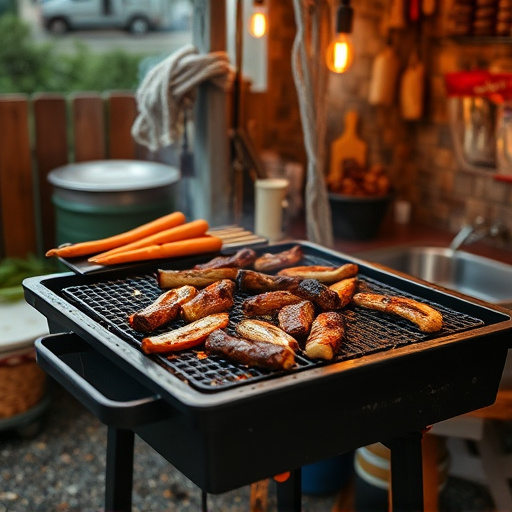
The art of BBQ is a time-honored tradition, transforming simple meats into mouthwatering delights. When it comes to a classic favorite like BBQ beef ribs, the process involves a delicate balance of smoke and sweet flavors that tantalize the taste buds. Start with a good quality cut of beef ribs, ensuring they are meaty and have a fair amount of marbling for juicy tenderness. Pre-soak wood chips in water for an hour to release their flavor; hickory or mesquite chips add a distinct smoky kick.
Preheat your smoker to around 250°F (120°C). Rub the ribs generously with a dry rub of brown sugar, paprika, salt, and pepper. Place them in the smoker, cover, and let the magic happen. The slow cooking allows the meat to tenderize as the smoke infuses its distinct flavor. Brush the ribs with BBQ sauce after 3-4 hours for added sweetness and stickiness. Continue smoking until the meat is falling-off-the-bone tender, a process that can take up to 8 hours or more, depending on the size of your ribs and smoker temperature.
Choosing the Right Beef Ribs for Your Dish

When crafting a dish that showcases smoky and sweet flavors, selecting the perfect BBQ beef ribs is key. Opt for cuts like baby back or St. Louis-style ribs, known for their marbling and tender texture. These rib types hold up well to slow-cooking methods, allowing the smoke to penetrate and caramelize sugars in the meat.
For a balanced profile, choose ribs with a good amount of fat cap. This natural fat renders during cooking, adding moisture and amplifying both smoky and sweet notes. Whether you’re following a specific BBQ beef ribs recipe or creating your own, the right rib selection will ensure every bite delivers that coveted combination of rich flavors.
Master the Dry Rub: Balancing Flavors
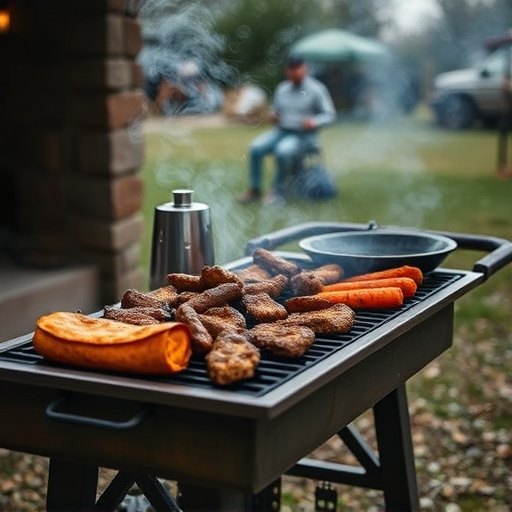
Mastering the art of dry rubbing is key to achieving that perfect balance of smoky and sweet flavors in your BBQ beef ribs recipe. The rub, a blend of spices, coats the meat, infusing it with aroma and taste during slow-cooking. To strike the right balance, consider a combination of brown sugar for sweetness, paprika for smokiness, salt for savoriness, and black pepper for a kick. Adjusting the proportions based on personal preference is essential; too much of one flavor can overpower the others.
Experimentation is encouraged until you find your ideal ratio. Once you’ve perfected your dry rub, it becomes the secret weapon in your BBQ arsenal, transforming simple beef ribs into mouthwatering, tender treats that satisfy both smoky and sweet cravings.
Smoking Technique: Achieving Perfection

The art of smoking meat is a precise science, especially when crafting a mouthwatering BBQ beef ribs recipe. The smoking technique plays a pivotal role in achieving that perfect balance of smoky and sweet flavors in every bite. It requires patience, attention to detail, and a deep understanding of wood types and heat control.
To master this, many chefs opt for low-and-slow cooking methods, allowing the meat to absorb the subtle aroma of burning wood. The choice of wood chips or chunks is crucial; hickory, mesquite, and oak are popular options known for their distinct flavors. Controlling the temperature and humidity is key; a steady heat ensures even cooking while moistening the ribs with regular basting. This meticulous process transforms the ribs, enhancing their texture and infusing them with the characteristic smoky taste sought after in any BBQ beef ribs recipe.
Glazing for That Extra Layer of Deliciousness
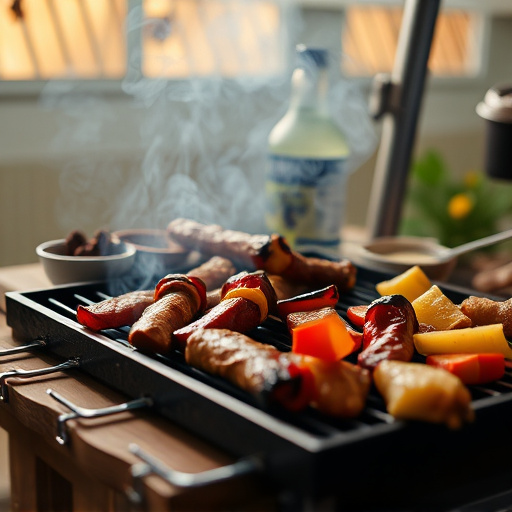
Glazing adds an irresistible extra layer of deliciousness to your BBQ beef ribs recipe, enhancing both flavor and appearance. It’s more than just a sauce; it’s a barrier that seals in juicy tender meat while adding a complex mix of smoky and sweet notes with every bite. A well-crafted glaze can transform simple ribs into a mouthwatering masterpiece, balancing the charred exterior with succulent interior.
When crafting your glaze, consider combining ingredients like brown sugar, barbecue sauce, Worcestershire sauce, and a touch of liquid smoke. This combination creates a rich, deep flavor that clings to the ribs, ensuring every strip is packed with deliciousness. Apply the glaze liberally during the last 15 minutes of cooking to achieve a glossy finish and an irresistible aroma that will have folks licking their plates clean.
Cooking Time and Temperature Considerations
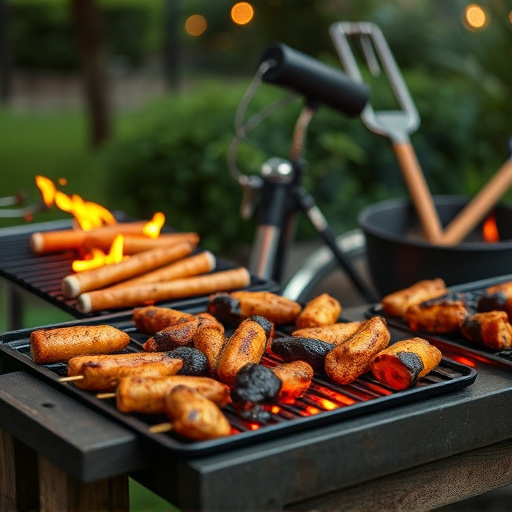
When crafting a mouthwatering BBQ beef ribs recipe, understanding cooking time and temperature is crucial for achieving that perfect balance of smoky and sweet flavors in every bite. The key lies in patience and precision. Typically, allowing your ribs to slowly cook at lower temperatures (around 225-250°F or 107-121°C) for an extended period ensures the meat becomes tender and absorbs the rich, smoky aromas from the BBQ sauce.
This slow cooking process can take anywhere from 3 to 4 hours, depending on the thickness of your ribs and your preferred level of doneness. Remember, the longer you cook, the more the moisture evaporates, so consistent basting with your favorite BBQ sauce is essential to keep the ribs moist and flavorful. This technique allows for a deep penetration of flavors, transforming tough cuts of meat into tender, succulent treats that truly satisfy.
Serving Suggestions to Impress Your Guests

Impress your guests with a mouthwatering BBQ Beef Ribs recipe that combines smoky and sweet flavors in every bite. For an unforgettable experience, pair these tender ribs with a side of crispy coleslaw or creamy potato salad. The contrast between the charred, savory notes from the grill and the balanced sweetness of the barbecue sauce will leave your diners craving more.
To elevate the presentation, consider serving the ribs on a large platter, garnished with fresh rosemary sprigs and a drizzle of barbecue sauce. Offer a variety of sauces for guests to customize their taste, adding a touch of personal preference to the dining experience. This simple yet effective approach will not only delight your guests but also make your meal an event to remember.
